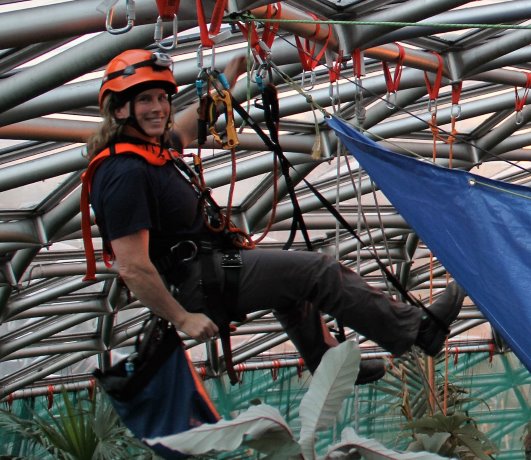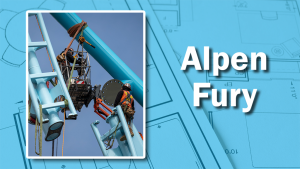The use of RATs in the construction industry is growing. Rope Access Technicians (RATs) use ropes to access confined spaces, areas where a crane or scaffolding can’t reach or is too costly to bring in or remote areas where no roads exist.
"Rope access is a growth industry," said marketing and business development manager Terrah Jong for Pacific Ropes, a company that does consulting, supplies RATs on construction projects and also operates a training facility for individuals who want to be certified.
The demand for RATs is spurred by varying construction demands, she said.
"Architecturally, buildings are becoming more complex. There is also a need for restoration work on older buildings. Often work has to be done with little environmental invasiveness or you need access to get into confined spaces which are often subterranean or in high places," she explained.
Pacific Ropes was the company that sent RATs into the far reaches of the Bloedel Conservatory during roof replacements at the structure.
The more recent Bloedel work involved providing a site safety netting system and interior painting services for the 21-metre-high and 43-metre-diameter triodetic dome.
"This alternative to scaffolding for the interior works provided many benefits, including cost and risk reduction and also allowing the conservatory to remain open for business," said Jong. "Alternative measures of building scaffolding would have required closure, removal of the birds and damage to the vegetation."
B.C. general manager Greg Korpela for Canadian Rope Access Specialists, which supplies technicians and also operates a training facility, said rope access is currently popular in the oil patch in its current down cycle as it proves a cost-effective means of facilities maintenance.
However, swinging from a rope at heights that can be as high as the CN Tower isn’t for the faint of heart; RATs go into tunnels, roofs, under bridges and even onto wind turbines.
"We have done a lot of work for BC Hydro," said Korpela, as roped technicians have rapelled down the face of dams checking its integrity. They can carry video equipment that captures images on the integral structure that engineers can study. Or, a RAT will serve as a guide, often helping an engineer gain rope access into an area where an engineer’s inspection is required. RATs have also descended into penstocks, after the water intake is locked off, to gain information on their condition, he said.
Vera Industrial Access, the largest rope access company on Vancouver Island, has also roped its way into remote places.
"We have done rock-drilling and blasting," said Andrew Clarke, owner, as Vera RATs have ventured into remote areas, disembarked and then rapelled down rock bluffs to drill detonation holes, set the charge and repelled back up the rock face to off the charge, one a 52-tonne blast, remotely.
Clarke, whose company started in Australia where a branch still exists, also operates a training facility but is in the process of building a new facility with a 50 to 60 foot climb for training purposes. The skill is highly portable and Vera has worked in South Africa, Thailand, Singapore and Dubai.
"We are hoping to begin an inspection contract in Seattle," he said and branch out to the U.S.
Clarke’s company has combined trade and professional skills with rope access skills. His 25-member RAT crew can carry out skills such as welding, electrical or drilling.
"We also have three engineers, a structural, material and mechanical engineer, who are also rope access technicians," he said.
Jong, in researching rope access, said the skill is derived from cavers and climbers who were oil industry employees and whose skills were then transferred neatly into that sector, especially in areas such as the North Sea where floating oil platforms provide no support for scaffolding. Much of the equipment supplied today is derived from manufacturers of mountaineering and cavers.
The International Rope Access Technician Association (IRATA) is headquartered in the United Kingdom and the Society of Professional Rope Access Technicians (SPRAT) is based in the United States. Both organizations certify technicians in accordance with the internationally accepted ISO 22846 standard on rope access. Industry research indicates that IRATA is well-established internationally and SPRAT is increasing in its global recognition.
"Alberta is really the province that pushed rope access technology," said Jong, as the oil and gas industry expertise was transferred into Canada’s resource sector in the late 1990s.
Newfoundland became the first province to adopt RAT regulations as it also used the technicians in its offshore oil industry. The move spread into construction where it is now one of the largest growth areas for companies offering rope access services. Last year, WorkSafeBC adopted regulations for those working in rope access on industrial sites.
Jong said rope access is also proving popular because it has been shown to have a low accident and fatality rate. IRATA publishes full investigation reports of fatalities involving certified members to ensure accidents are not duplicated.
As well, RATs are trained in how to carry out a rescue on site.
Certification requirements for RATs are stringent. Individuals can complete three levels. Level 1 provides skills in using rope access, Level 2 provides the ability to implement rigging, while Level 3 provides supervisor and manager skills for overseeing an operation.
Each training course at a recognized institution that has IRATA or SPRAT trainers, culminates with an independent outside evaluator for the students. Attaining each skill level requires four full days of training with a fifth day of testing. Moving between the different levels under IRATA requires a person to perform 1,000 hours of practical experience. When Level 1 or 2 RATs work on site, they are required to be supervised by a Level 3 RAT. RATs must renew their certification every three years.
Korpela said the growth of rope access boils down to cost.
"Rope access projects work where the cost of the amount of work performed is disproportionate to regular access costs," he said.

1/2
Rope Access Technicians (RATs) at Pacific Ropes were called to help with the Bloedel Conservatory roof replacement negating the need to bring in scaffolding at the triodetic dome, a structure that houses 200 birds as well as 500 species of plants. Pacific Rope RATs were also used on the BC Place roof replacement when a crane could not be brought in to do the work.
Photo: Pacific Ropes
2/2
Pacific Ropes











Recent Comments
comments for this post are closed